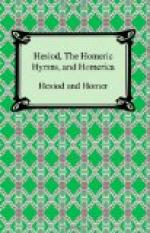to Stasinus of Cyprus.
(39) This fragment is placed by Spohn after “Works and Days” l.
120.
(40) A Greek of Asia Minor, author of the “Description of Greece”
(on which he was still engaged in 173 A.D.).
(41) Wilamowitz thinks one or other of these citations belongs to
the Catalogue.
(42) Lines 1-51 are from Berlin Papyri, 9739; lines 52-106 with
B. 1-50 (and following fragments) are from Berlin Papyri,
10560. A reference by Pausanias (iii. 24. 10) to ll. 100
ff. proves that the two fragments together come from the
“Catalogue of Women”. The second book (the beginning of
which is indicated after l. 106) can hardly be the second
book of the “Catalogues” proper: possibly it should be
assigned to the EOIAI, which were sometimes treated as part
of the “Catalogues”, and sometimes separated from it. The
remains of thirty-seven lines following B. 50 in the Papyrus
are too slight to admit of restoration.
(43) sc. the Suitor whose name is lost.
(44) Wooing was by proxy; so Agamemnon wooed Helen for his
brother Menelaus (ll. 14-15), and Idomeneus, who came in
person and sent no deputy, is specially mentioned as an
exception, and the reasons for this — if the restoration
printed in the text be right — is stated (ll. 69 ff.).
(45) The Papyrus here marks the beginning of a second book ("B"),
possibly of the EOIAE. The passage (ll. 2-50) probably led
up to an account of the Trojan (and Theban?) war, in which,
according to “Works and Days” ll. 161-166, the Race of
Heroes perished. The opening of the “Cypria” is somewhat
similar. Somewhere in the fragmentary lines 13-19 a son of
Zeus — almost certainly Apollo — was introduced, though
for what purpose is not clear. With l. 31 the destruction
of man (cp. ll. 4-5) by storms which spoil his crops begins:
the remaining verses are parenthetical, describing the snake
`which bears its young in the spring season’.
(46) i.e. the snake; as in “Works and Days” l. 524, the “Boneless
One” is the cuttle-fish.
(47) c. 1110-1180 A.D. His chief work was a poem, “Chiliades”,
in accentual verse of nearly 13,000 lines.
(48) According to this account Iphigeneia was carried by Artemis
to the Taurie Chersonnese (the Crimea). The Tauri
(Herodotus iv. 103) identified their maiden-goddess with
Iphigeneia; but Euripides ("Iphigeneia in Tauris”) makes her
merely priestess of the goddess.
(49) Of Alexandria. He lived in the 5th century, and compiled a
Greek Lexicon.
(50) For his murder Minos exacted a yearly tribute of boys and
girls, to be devoured by the Minotaur, from the Athenians.
(51) Of Naucratis. His “Deipnosophistae” ("Dons at Dinner”) is
(39) This fragment is placed by Spohn after “Works and Days” l.
120.
(40) A Greek of Asia Minor, author of the “Description of Greece”
(on which he was still engaged in 173 A.D.).
(41) Wilamowitz thinks one or other of these citations belongs to
the Catalogue.
(42) Lines 1-51 are from Berlin Papyri, 9739; lines 52-106 with
B. 1-50 (and following fragments) are from Berlin Papyri,
10560. A reference by Pausanias (iii. 24. 10) to ll. 100
ff. proves that the two fragments together come from the
“Catalogue of Women”. The second book (the beginning of
which is indicated after l. 106) can hardly be the second
book of the “Catalogues” proper: possibly it should be
assigned to the EOIAI, which were sometimes treated as part
of the “Catalogues”, and sometimes separated from it. The
remains of thirty-seven lines following B. 50 in the Papyrus
are too slight to admit of restoration.
(43) sc. the Suitor whose name is lost.
(44) Wooing was by proxy; so Agamemnon wooed Helen for his
brother Menelaus (ll. 14-15), and Idomeneus, who came in
person and sent no deputy, is specially mentioned as an
exception, and the reasons for this — if the restoration
printed in the text be right — is stated (ll. 69 ff.).
(45) The Papyrus here marks the beginning of a second book ("B"),
possibly of the EOIAE. The passage (ll. 2-50) probably led
up to an account of the Trojan (and Theban?) war, in which,
according to “Works and Days” ll. 161-166, the Race of
Heroes perished. The opening of the “Cypria” is somewhat
similar. Somewhere in the fragmentary lines 13-19 a son of
Zeus — almost certainly Apollo — was introduced, though
for what purpose is not clear. With l. 31 the destruction
of man (cp. ll. 4-5) by storms which spoil his crops begins:
the remaining verses are parenthetical, describing the snake
`which bears its young in the spring season’.
(46) i.e. the snake; as in “Works and Days” l. 524, the “Boneless
One” is the cuttle-fish.
(47) c. 1110-1180 A.D. His chief work was a poem, “Chiliades”,
in accentual verse of nearly 13,000 lines.
(48) According to this account Iphigeneia was carried by Artemis
to the Taurie Chersonnese (the Crimea). The Tauri
(Herodotus iv. 103) identified their maiden-goddess with
Iphigeneia; but Euripides ("Iphigeneia in Tauris”) makes her
merely priestess of the goddess.
(49) Of Alexandria. He lived in the 5th century, and compiled a
Greek Lexicon.
(50) For his murder Minos exacted a yearly tribute of boys and
girls, to be devoured by the Minotaur, from the Athenians.
(51) Of Naucratis. His “Deipnosophistae” ("Dons at Dinner”) is




